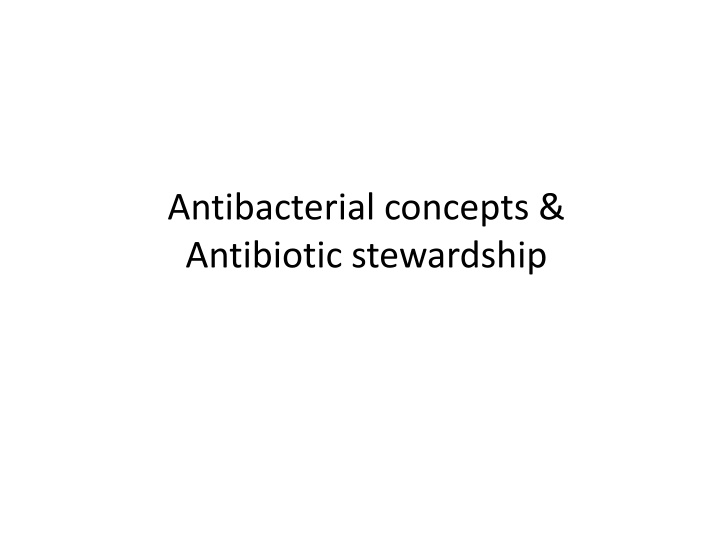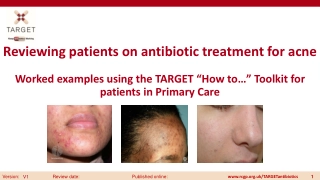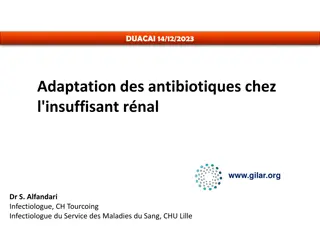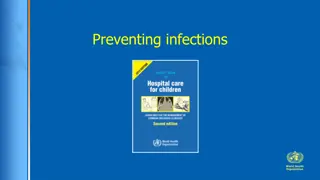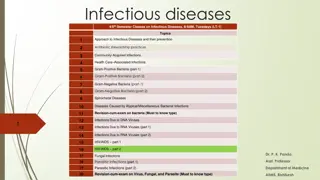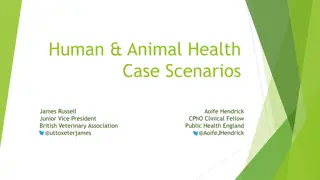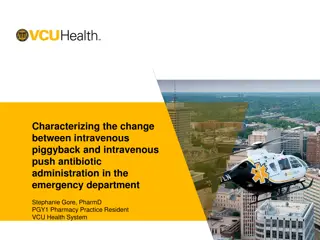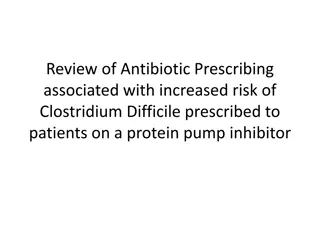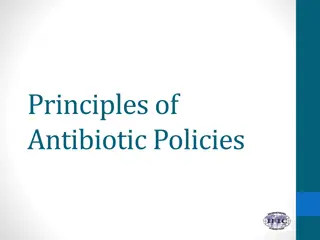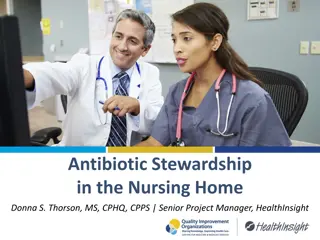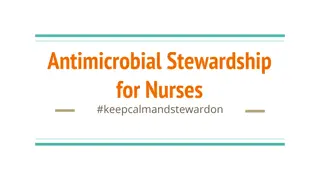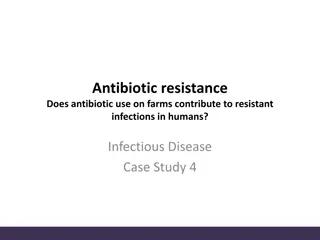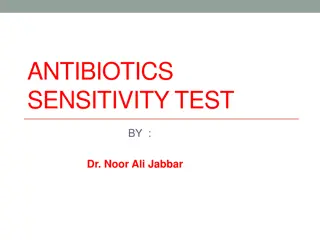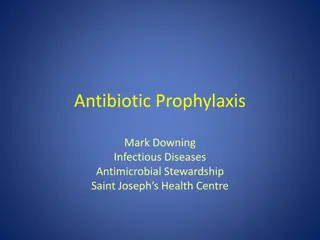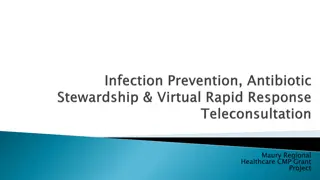Antibacterial Concepts and Antibiotic Stewardship
key concepts related to pharmacokinetics, pharmacodynamics, drug interactions, adverse reactions, IV vs. oral antibiotics, therapeutic monitoring, limitations, and more in antibiotic usage and stewardship.
Download Presentation

Please find below an Image/Link to download the presentation.
The content on the website is provided AS IS for your information and personal use only. It may not be sold, licensed, or shared on other websites without obtaining consent from the author.If you encounter any issues during the download, it is possible that the publisher has removed the file from their server.
You are allowed to download the files provided on this website for personal or commercial use, subject to the condition that they are used lawfully. All files are the property of their respective owners.
The content on the website is provided AS IS for your information and personal use only. It may not be sold, licensed, or shared on other websites without obtaining consent from the author.
E N D
Presentation Transcript
Antibacterial concepts & Antibiotic stewardship
Objectives Know concepts relating to pharmacokinetics and pharmacodynamics of antibiotics including probability of target attainment. Know concepts of antibiotic stewardship Know common drug interactions with antibiotics (as listed in the lecture) Know common antibiotic adverse reactions and side effects (as listed in the lecture) Understand principals and practice relating to decisions about administering intravenous or oral antibiotics and durations of antibiotic treatment Be familiar with common antibiotic allergies and how these change antibiotic prescribing (as described in the lecture) Be familiar with common antibiotics with cautions/contra-indications in pregnancy (as listed in the lecture) Understand the concepts behind therapeutic drug monitoring (as described in the lecture) Understand limitations of antibiotics Know when to start antibiotics Know the evidence for surgical antibiotic prophylaxis
Will the antibiotic work? Or will it just make you worse?
Consider Mr Smith is a 70 year old man admitted with an MRSA bacteraemia following a pneumonia. He is being treated once daily with 400mg of an antibiotic called teicoplanin. After five days of antibiotics Mr Smith has improved. Blood levels of teicoplanin are collected and find his level of teicoplanin is 15mg/L. Below the recommended therapeutic blood levels of >20 mg/L. Mr Smith is much improved. What could be a reasonable thing to do with his teicoplanin? Continue the same dose Increase the dose to 800mg Give 400mg twice a day Reduce the dose
The MIC Bacteria cause infections Bacterial infections are treated with antibiotics that inhibit bacterial growth We test bacteria to see how susceptible they are to an antibiotic. To test how susceptible to an antibiotic a bacteria is we determine the minimum amount of antibiotic that stops the bacteria from growing-the minimum inhibitory concentration (MIC)
The MIC MIC: Minimum Inhibitory Concentration The minimum concentration of antibiotic which inhibits bacterial growth Standard culture media Standard bacterial inoculum The only variable is antibiotic concentration Increasing antibiotic concentration
MIC and surviving an infection Increasing time blood antibiotic concentrations are above the MIC We dose antibiotics to try and ensure all patients get blood concentrations of antibiotic that are associated with increased survival
There are intra-species variations in MIC values So antibiotic treatment considers bacterial populations and the variation within it
What we know We know The MIC value is measurable The MIC value is important The MIC value varies The MIC needs to be considered in relation to serum concentrations of antibiotic
Antibiotic pharmacokinetics and pharmacodynamics (PK/PD)
Relationships between drug concentrations and antibiotics
Targets Look at the antibiotic concentration-efficacy relationships/graph Can you tell me where on this graph we should aim for? This is your target As we are talking about the action of a drug on an organism (bacteria) this is your pharmacodynamic target After the target has been achieved, there is no additional efficacy benefit antibiotics are dosed to achieve the target, but not to exceed the target we should give enough drug, not more and more drug
Antibiotic concentration profiles (antibiotic pharmacokinetics) There is lots of variation between patients in how antibiotic is: Distributed in the body Cleared from the body Antibiotic dosing must consider pharmacokinetic variation
What we know The MIC is important in relation to cure Antibiotic pharmacokinetics are important to cure MIC and PK values vary The PD target is fixed
Simulations The information we have gone over MIC PK PD targets is used in statistical simulations to predict optimal antibiotic doses
Simulations The MIC and PK data can be described using probabilities The PD target will be fixed Statistical analyses (simulations) can be used to determine the probability that, if treated with a certain antibiotic dose, for a certain infection, a patient will attain the desired pharmacodynamic target. This is called the probability of target attainment (PTA). Clinical Infectious Diseases, Volume 44, Issue 1, 1 January 2007, Pages 79 86,https://doi.org/10.1086/510079
Simulations For a drug dose of X- the cure rate would be 80% Simulation number MIC (mg/L) Drug clearance PD target Probability of target attainment Outcome 1 4 Low T>MIC 50% High Cure 2 0.5 High T>MIC 50% High Cure 3 4 High T>MIC 50% Low Death 4 1 Low T>MIC 50% High Cure 5 2 Medium T>MIC 50% High Cure With a dose of 2X- maybe there will be cure rate of 100%, and this dose selected If the 2X dose has an acceptable toxicity profile, the antibiotic can be used to treat patients
How does these concepts help me with my patient? Know that antibiotic dosing is carried out for a population of patients Most patients will get enough antibiotic Some patients may get too much Some patients may get too little
Mr Smith Mr Smith is recommended to have Teicoplanin blood levels of >20 mg/L. Mr Smith has got much better-it is possible his bacterial infection had a lower MIC than the average persons MIC. If the MIC is lower the amount of drug required may be lower, so 15mg/L might be enough for him. But all options may be reasonable, so continue the same dose of drug if he is at risk of drug toxicity-and his infection is mild increase the dose, or dose frequency to achieve therapeutic levels in some more serious infections to reduce the risk/probability of death If the microbiology lab gives you an MIC-you might be able to reduce the dose As a doctor you will need to use your informed judgment to decide what to do.
Oral versus intravenous antibiotics Oral Intravenous Slower absorption Faster/Instantaneous absorption Antibiotic associated diarrhoea Requires small bowel for absorption No bowel required for absorption Absorption may vary Absorption rate can be varied No intravenous (IV) access required IV access required No IV access side effects IV access side effects: Thrombophlebitis, thrombosis and infection Self-administration Medical staff required for administration Cheaper More expensive Efficacy They need IV antibiotics When the drug has reached the systemic circulation IV and PO antibiotics can be considered equal. There are no mythical properties of IV antibiotics
Oral or intravenous antibiotics Oral antibiotics have ben shown to be comparable to intravenous antibiotics for a number of infections including: Bone and joint infection Pyelonephritis Empyema (lung abscess) Febrile neutropenia in cancer patients Intravenous antibiotics may be important to quickly and reliably achieve targeted serum antibiotic concentrations. Some drugs are only available intravenously Some antibiotics are not well absorbed orally
An oral or intravenous antibiotic example Ciprofloxacin IV dose=400mg 12 hourly PO dose=500mg 12 hourly Oral bioavailability =80% Both IV and PO antibiotics have 400mg BD bioavailable-on average
Antibiotic durations As durations increase, adverse events increase As durations increase, failure rates decrease But diminishing returns Increasing duration of antibiotics Antibiotic durations are chosen to try and maximise cure while minimising adverse events
Antibiotic duration strategies Short course for all Long course for all Clinical response Biomarker driven Imaging strategy Choice depends upon Evidence Clinical factors Social factors Costs Resources available
When to start antibiotics Antibiotics should be started when the benefits of starting are greater than the disadvantages. There are times when antibiotics should always be started e.g. patients with sepsis, and there are times when antibiotics should never be started e.g. patients with no evidence of infection e.g. auto-immune inflammation. In-between, individual patient factors may mean antibiotics may or may not be started. It can be reasonable not to start antibiotics in a patient with an infection, but this must be done within the context of an overall management plan e.g. a patient with a skin abscess may not be given antibiotics if there is a plan for surgical drainage of the abscess.
Early antibiotic therapy Benefits Disadvantages Early treatment with mortality and morbidity benefit May reduce the time available to do cultures reduced chance of giving targeted therapy reduced chance of getting a diagnosis (the pathogen may give the diagnosis) If clinically stable narrow spectrum antibiotics may be administered and the response assessed May reduce time to do investigations i.e. overtreatment possible If clinically stable an oral antibiotic may be administered and the response assessed. May increase the chance of giving the wrong antibiotic, or not enough antibiotic Prevent infection metastases Insufficient time to check allergies
Starting antibiotics-strategies Start antibiotics early, and look to stop/de- escalate early Delay antibiotics-with plan for how/when to access/start antibiotics e.g. delayed prescription Start broad, and look to narrow Start narrow, and have a plan for how/when to broaden.
Therapeutic drug monitoring TDM used for vancomycin/teicoplanin (gylcopeptides) and gentamicin (aminoglycosides) -both ototoxic and nephrotoxic drugs -efficacy can be reduced if sub-therapeutic levels
Surgical antibiotic prophylaxis Medicine (Baltimore). 2017 Jul; 96(29): e6903.
Antibiotic stewardship A coherent set of actions which promote using antimicrobials responsibly Antimicrobial Prescribing Facts: The 30% Rule ~ 30% of all hospitalised inpatients at any given time receive antibiotics Over 30% of antibiotics are prescribed inappropriately in the community Up to 30% of all surgical prophylaxis is inappropriate ~ 30% of hospital pharmacy costs are due to antimicrobial use 10-30% of pharmacy costs can be saved by antimicrobial stewardship programs
Antibiotic stewardship Antimicrobial stewardship: is an inter-professional effort, across the continuum of care involves timely and optimal selection, dose and duration of an antimicrobial for the best clinical outcome for the treatment or prevention of infection with minimal toxicity to the patient and minimal impact on resistance and other ecological adverse events such as C. difficile
Antibiotic stewardship Clinical guidelines IV to PO switch Antibiotic restriction Microbiologist support Education Use of biomarkers Audit and feedback http://bsac.org.uk/practical-guide- to-antimicrobial-stewardship-in- hospitals/
Antibiotic interactions-a few examples Antibiotic Interaction Penicillins/Beta-lactams e.g. amoxicillin Limited interactions Reduces excretion of methotrexate Quinolones e.g. ciprofloxacin Alters phenytoin concentrations Macrolides e.g. clarithromycin Enhance anticoagulant effect Increases plasma phenytoin concentrations Increase plasma digoxin concentrations Trimethoprim Hyperkalaemia with ACE inhibitors Nephrotoxicity with cyclosporin Glycopeptides e.g. teicoplanin Increased nephrotoxicity with aminoglycosides Loop diuretics Linezolid Serotonin syndrome Aminoglycosides Ototoxicity with frusemide
Antibiotic adverse reactions and side effects-a few examples Antibiotic Reaction/Side effect Penicillins/Beta-lactams e.g. amoxicillin Allergic reactions Amoxicillin-clavulanic acid Cholestatic jaundice Quinolones e.g. ciprofloxacin Tendonitis Prolonged QT interval Macrolides e.g. clarithromycin Diarrhoea (prokinetic) Trimethoprim Erythema multiforme Glycopeptides Ototoxicity and nephrotoxicity Red man syndrome (vancomycin) Linezolid Optic neuropathy Blood disorders Aminoglycosides Ototoxicity, Nephrotoxicity All Antibiotic associated diarrhoea Clostridium difficile infection Metronidazole Disulfiram reaction with alcohol
Antibiotics in pregnancy-the main ones to be aware of Known risks Quinolones e.g. ciprofloxacin Arthropathy in animal studies Teratogenic in 1st trimester Trimethoprim (folate antagonist) Aminoglycosides Ototoxicity Nitrofurantoin Avoid at term-neonatal haemolysis Other Often insufficient evidence See manufacturers recommendations See BNF
Penicillin allergy Beta lactam antibiotics refers to antibiotics that have a Beta-lactam ring as part of its chemical structure There are different classes of beta-lactams e.g. Penicillins Cephalosporins Carbapemems 10% of people report a penicillin allergy Penicillins end in -illin Amoxicillin Amoxicllin-clavulanic acid (augmentin) Piperacillin-tazobactam (tazocin) Flucloxacillin Patients with a penicillin allergy may also cross react to other beta-lactam antibiotics e.g. Cephalosporins e.g. cefuroxime Penicillin allergy may be lost over time
LTHT Algorithm for management of a patient with penicillin allergy Patient presents with History of Penicillin Allergy History of Allergy given is CLEAR? Yes No History of History of ANAPHYLAXIS/ SEVERE REACTION History of DELAYED TYPE HYPERSENSITIVITY Patient has been re-challenged with penicillins WITHOUT reaction SIDE EFFECT ONLY No Yes Yes Yes Yes If CLEAR Delayed Type reaction could consider graded challenge SAFE to give penicillin if that is the most suitable antibiotic AVOID penicillins Use SAFE ALTERNATIVE AVOID penicillins Use SAFE ALTERNATIVE Otherwise AVOID antibiotic Use SAFE ALTERNATIVE Indicated Side effects of antibiotic or infection Indicates Anaphylaxis/Severe Reaction Possible delayed type reaction Nausea/Vomiting Swelling (e.g. mouth/tongue/face etc.) Itching Rash Diarrhoea/stomach upset Problems breathing Onset some days after starting antibiotic Headache/dizziness Wheals or raised rash Flat (non-raised) Rash Family history of allergy Low Blood Pressure/Tachycardia Thrush Collapse/unconsciousness Metalic taste/altered taste in mouth Hospitalised/needed ventilation Lethargy/Feeling tired Blistering
Limitations of antibiotics Antibiotics will not treat non-infectious diseases Antibiotics will not treat contaminated samples Antibiotics may only be the supporting actor in some infections that require surgical intervention All antibiotics damage your microbiome
Thank you for your time Any questions?
